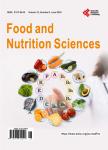Nutrient Analysis Critical Control Point (NACCP): Hazelnut as a Prototype of Nutrigenomic Study
Nutrient Analysis Critical Control Point (NACCP): Hazelnut as a Prototype of Nutrigenomic Study作者机构:Department of Agricultural Sciences University of Reggio Calabria “Mediterranea” Reggio Calabria Italy Department of Agricultural Forest and Food Sciences (DISAFA) University of Turin Grugliasco Italy Section of Section of Clinical Nutrition and Nutrigenomic Department of Biomedicine and Prevention University of Rome “Tor Vergata” Roma Italy Section of Section of Clinical Nutrition and Nutrigenomic Department of Biomedicine and Prevention University of Rome “Tor Vergata” Roma Italy I.N.DI.M. National Institute for Mediterranean Diet and Nutrigenomics Amantea Italy.
出 版 物:《Food and Nutrition Sciences》 (食品与营养科学(英文))
年 卷 期:2014年第5卷第1期
页 面:79-88页
学科分类:1002[医学-临床医学] 100214[医学-肿瘤学] 10[医学]
主 题:NACCP Process Hazelnut Nutrigenomic Oxidative Stress LDL-Oxidation
摘 要:The aim of this study is to apply the Nutrient Analysis Critical Control Point (NACCP) process to ensure that the highest nutrient levels in food can determine a beneficial effect on the health of the consumer. The NACCP process involves a sequence of analysis and controls that depart from raw material production to the evaluation of the effect of nutrition on health. It is articulated through the following points: 1) identification of nutrient level in the food;2) identification of critical control points (environmental, genetic data, chemical and physical data, production technology, distribution and administration);3) establishing critical limits that can impoverish and damage the nutrient;4) establishing measures to monitor;5) establishing corrective actions. We selected as biomarkers the total phenolic content (TPC) and total antioxidant capacity (TAC) of a genotyped Italian hazelnut cultivars (Corylus e avellana L.). We performed a clinical study evaluating: a) nutritional status;b) clinical-biochemical parameters;c) low density lipoprotein oxidation (LDL-ox);d) the expression level changes of oxidative stress pathway genes in the blood cell at baseline and after 40 g/die of hazelnut consumption. In this study, we found a significant lowering (p ≤ 0.005) of LDL oxidized proteins, in association with the consumption of 40 g/d of hazelnuts. Also, we found a significant variation (p ≤ 0.005) of gene expression of antioxidant and pro-oxidant genes, between the intake of dietary with and without hazelnuts. This results support the hypothesis that the NACCP process could be applied to obtain significant benefits in terms of primary prevention and for contributing to the amelioration of food management at the consumer level.



